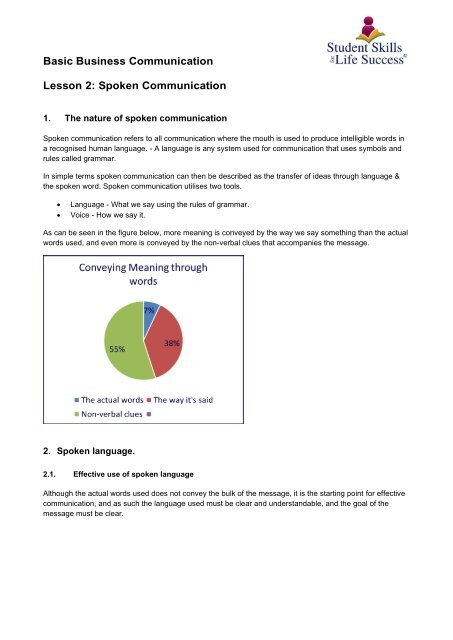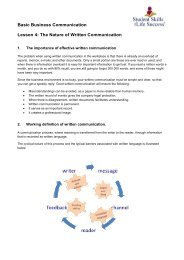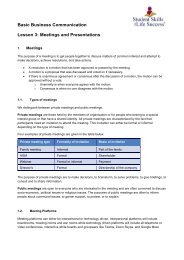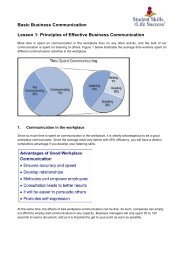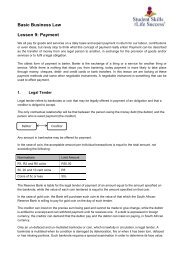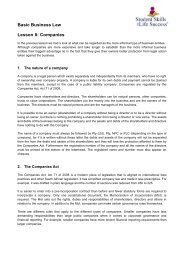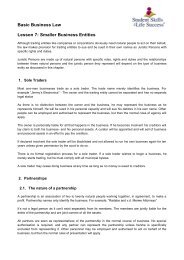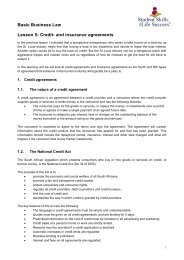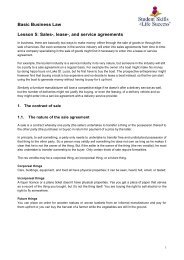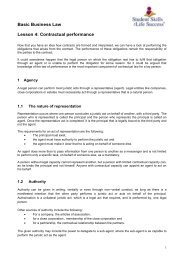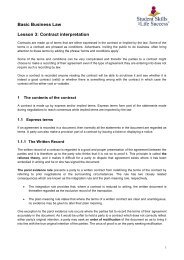Basic Business Communication. Lesson 2. Spoken Communication
This is the second lesson for Basic Business Communication. The following topics are covered in this lesson: 1. The nature of spoken communication 2. Spoken language 3. Aspects of voice 4. Direct vs indirect speech 5. Planning to speak 6. Spoken communication in the workplace Video Links https://youtu.be/3ScVSAJjQkQ?si=E33-mTxk0mQtjsMl https://youtu.be/ybuXntdPAWY?si=psgfHxUe0xn1Cd4o
This is the second lesson for Basic Business Communication. The following topics are covered in this lesson:
1. The nature of spoken communication
2. Spoken language
3. Aspects of voice
4. Direct vs indirect speech
5. Planning to speak
6. Spoken communication in the workplace
Video Links
https://youtu.be/3ScVSAJjQkQ?si=E33-mTxk0mQtjsMl
https://youtu.be/ybuXntdPAWY?si=psgfHxUe0xn1Cd4o
Create successful ePaper yourself
Turn your PDF publications into a flip-book with our unique Google optimized e-Paper software.
<strong>Basic</strong> <strong>Business</strong> <strong>Communication</strong><br />
<strong>Lesson</strong> 2: <strong>Spoken</strong> <strong>Communication</strong><br />
1. The nature of spoken communication<br />
<strong>Spoken</strong> communication refers to all communication where the mouth is used to produce intelligible words in<br />
a recognised human language. - A language is any system used for communication that uses symbols and<br />
rules called grammar.<br />
In simple terms spoken communication can then be described as the transfer of ideas through language &<br />
the spoken word. <strong>Spoken</strong> communication utilises two tools.<br />
• Language - What we say using the rules of grammar.<br />
• Voice - How we say it.<br />
As can be seen in the figure below, more meaning is conveyed by the way we say something than the actual<br />
words used, and even more is conveyed by the non-verbal clues that accompanies the message.<br />
<strong>2.</strong> <strong>Spoken</strong> language.<br />
<strong>2.</strong>1. Effective use of spoken language<br />
Although the actual words used does not convey the bulk of the message, it is the starting point for effective<br />
communication, and as such the language used must be clear and understandable, and the goal of the<br />
message must be clear.
Good language will be…<br />
• grammatically correct in terms of the nouns, verbs, adjectives,<br />
conjunctions, etc. used.<br />
• in the correct word order<br />
• clear and unambiguous<br />
• suited to the audience.<br />
Some language goals are:<br />
• To provide information<br />
• To express emotions<br />
• To influence others<br />
• To have contact with others<br />
• To provide pleasure (Prose & poetry)<br />
<strong>2.</strong><strong>2.</strong> Ineffective use of spoken language<br />
There are certain words and phrases whose very use can render our communication ineffective. The table<br />
below summarises these language types with a short description and an example of each.<br />
Language Type Description Example<br />
Cliché An overused expression Don’t judge a book by its cover<br />
Abbreviation Shortening a word RSVP / ASAP / ETA<br />
Jargon<br />
Words used by people of a specific<br />
trade or profession<br />
Tech Talk<br />
Slang Words that takes on another meaning “Howzit, my bra.”<br />
Redundancy Using unnecessary words A dead body was discovered<br />
Parrot speak Over rehearsed words Telemarketers<br />
Buzz words Popular words, used without thinking Going Viral / Marketing funnels<br />
Discriminatory<br />
language<br />
Prejudiced or biased<br />
Old people are bad drivers.<br />
Manipulative<br />
language<br />
Language to make<br />
you fearful<br />
Small talk / arbitrary<br />
chatter<br />
Controlling others with what and how<br />
you say it<br />
Language to warn or change<br />
behaviour<br />
Random chit-chat<br />
Are you really going to eat that?<br />
Danger! Gevaar! Ingozi!<br />
Nice weather we’re having.
3. Aspects of the voice.<br />
Even if we use good language, if we do not have good voice control our spoken communication will be<br />
ineffective. The table below summarises some of these voice aspects, with a short description of each and a<br />
tip on how to improve that aspect of your voice.<br />
Aspect Explanation Improvement Tip<br />
Pitch High or low / Treble or base Avoid the extremes<br />
Volume Loud or soft Adjust for room size<br />
Tone Reflects attitude Show happy/sad/angry/caring<br />
Rate/tempo Quickly or slowly Vary your pace & rhythm<br />
Breath control Not running out of breath Keep it normal. Breathe deeply if you’re nervous<br />
Articulation How clearly you speak Say it once / Use your lips<br />
Projection Getting the audience to hear you Project, don’t shout!<br />
Pronunciation The way we say words Sound the vowels correctly<br />
Relaxation Indicates calm Assertive - Not passive / aggressive<br />
4. Direct vs indirect speech.<br />
Direct speech requires a face-to-face meeting with at least one other person but includes small group<br />
discussions or an individual speaking to a large group.<br />
The communication can be formal or informal, it can be one-way or two-way with feedback and it will be<br />
accompanied by non-verbal gestures.<br />
The advantages of direct speech are listed below.
Whereas direct speech requires a face-to-face meeting with other people,<br />
indirect speech requires a meeting device. Examples of indirect speech includes<br />
phone – and conference calls, addresses over a PA system, or radio and TV broadcasts.<br />
The characteristics of indirect communication are that there is no eye contact, and it is fast and convenient.<br />
Like direct communication, it can be one-way or two-way, and it can be with or without feedback.<br />
The advantages of indirect speech are listed below.<br />
5. Planning to speak.<br />
In our normal day-to-day interaction with friends and family, we will always speak spontaneously, but when<br />
we have to speak in a formal capacity, it is important to plan before we speak. The figure below sets out the<br />
four-step preparation of prepare, practice, deliver and master.
6. <strong>Spoken</strong> communication in the workplace.<br />
The use of spoken communication in the workplace is vast and unavoidable. Some of the uses of spoken<br />
communication in the workplace include the following:<br />
• Informal group discussions<br />
• Giving instructions & directions<br />
• Explaining or solving problems<br />
• Interviews<br />
• Training<br />
• Coaching<br />
• Meetings<br />
• Presentations<br />
• Customer interactions<br />
• Phone calls<br />
We are going to have a closer look at some of these.<br />
6.1. Interviews<br />
The use of interviews in the workplace is illustrated below.<br />
Oxford Interviews are a special class of interviews to assess if the candidate is able to think outside of norm.<br />
Below are a couple of interesting questions in this interview class.<br />
• Would it be okay for monkeys to experiment on humans?<br />
• Was Shakespeare high when he wrote “A Midsummer Night’s Dream?”<br />
• Is it okay for an economist to be poor?
6.<strong>2.</strong> Training and Coaching<br />
The difference between training and coaching is outline below.<br />
6.3. Brainstorming<br />
Brainstorming is the exchange ideas with limit rationalization & criticism. While it can turn a bit chaotic, there<br />
are ways to making it mor structured, like using De Bono’s 6-Hatsmethodology, that is summarized below.


